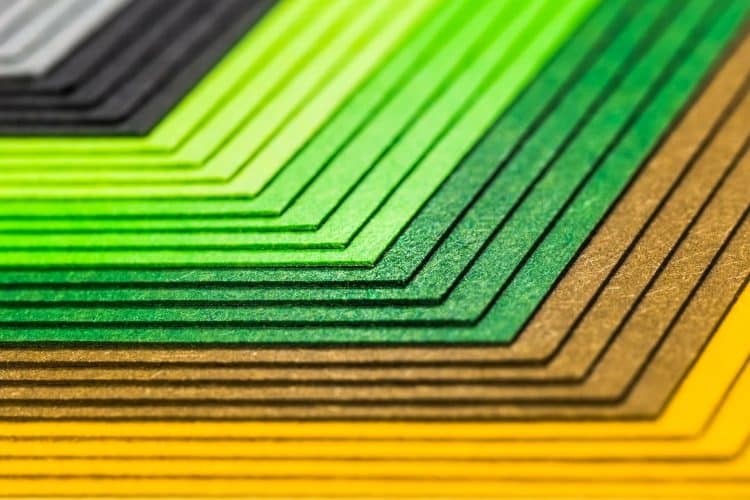Different types of chromatography can be used for the production-scale purification and isolation of cannabinoids from cannabis. Centrifugal partition chromatography (CPC) uses liquid-liquid partitioning with one phase made immobile from centrifugal force. [1] In 2019, Popp et al [2] highlighted the successful development of a “pH-zone-refining method” for CPC isolation of acidic cannabinoids such as cannabidiolic acid (CBDA) and cannabidivarinic acid (CBDVA).
The researchers note an earlier study by Hazekamp et al [1] where CPC was used for acidic cannabinoids with success, but the procedure required prior fractionation of the extract to target acidic cannabinoids. [2] The authors posit that a pH-zone-refining mode could be used for “enhanced loading capacity, minimum overlap of rectangular compound peaks and concentration of fractions near saturation level.” [2]
The pH-zone-refining process involves adding acidic/basic compounds to solvents to control pH and act as retainers (to retain target compounds) or eluters (to elute target compounds). [3] The chromatographer can use this method to modulate which chemicals they target based on hydrophobicity and acid dissociation constant (pKa) values. [3]
In this study, researchers created extract using fiber-type hemp (Fedora 17) and supercritical fluid extraction (100% CO2, 15 MPa (extraction)/4MPa (separators), 35° C/30° C, 5 kg/h flow rate). [2] They then employed an FCPC 1000® CPC instrument and used n-hexane/ethyl acetate/ethanol/water at 8:2:5:5 (v/v/v/v) as the solvent system. The researchers reduced the pH of n-hexane (n-hex) and ethyl acetate (EtOAc), the stationary phase, to 2 by adding 100 millimolar (mM) trifluoroacetic acid (TFA) as a retainer. The mobile phase—ethanol (EtOH) and water (H2O)—was altered with 80 mM triethylamine (TEA) to elevate the pH to 10 and act as an eluter. They proceeded as follows:
- Filled column with n-hex/EtOAc at 25 mL/min and set to 200 rotations per minute (rpm).
- Injected 9 grams of extract in 40 ml of acidic (low pH) n-hex/EtOAc and neutral 5 mL EtOH/H2 Increased rpm to 650.
- Added high pH mobile phase; fractionated at 10 mL/min (11 fractions), 15 mL/min (42 fractions), and 20 mL/min for extrusion (45 fractions).
Using thin-layer chromatography, the researchers selected thirteen of the most similar fractions for combination and analysis. They noted that “Most of the CBDA contained in the extract was collected in the fractions F20-F28.” In fact, one fraction was responsible for about 13% of the CBDA in the entire extract. CBDA and CBDVA purities exceeding 95% and 85%, respectively, were obtained at 45% recovery rates.
The speed of the process is one reason the study authors consider the pH-zone-refining method a success. They report that “more than 65% of CBDA (purity>90%) contained in the extract can be recovered in less than 80 min.” They also tout the use of ethanol and water as cost effective and sustainable. In conclusion, the method “could be adaptable for the isolation of other major and minor acidic cannabinoids naturally occurring in different C. sativa varieties.” [2] Conversely, the speed seems necessary given the 9-gram throughput used in the study, which may affect scalability.
References
- Hazekamp A, et al. “Preparative Isolation of Cannabinoids from Cannabis sativaby Centrifugal Partition Chromatography.” Journal of Liquid Chromatography & Related Technologies, vol.27, no.15, 2004, pp. 2421–2439. Journal Impact Factor: 0.987; Times Cited: 57
- Popp JR, et al. “Rapid Isolation of Acidic Cannabinoids from Cannabis sativa Using pH-Zone-Refining Centrifugal Partition Chromatography.” Journal of Chromatography A, vol.1599, 2019, pp.196-202. Impact Factor: 3.858; Times Cited: 2
- Ito Y. “pH-Zone-Refining Counter-Current Chromatography: Origin, Mechanism, Procedure and Applications.” Journal of Chromatography A, 1271, no.1, 2013, pp.71–85,doi:10.1016/j.chroma.2012.11.024. Impact Factor: 3.858; Times Cited: 70
Image by Alexander Stein from Pixabay











